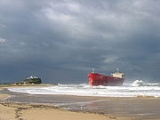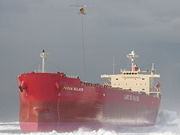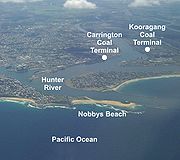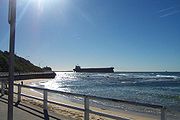
MV Pasha Bulker
Encyclopedia
The MV Pasha Bulker is a Panamax
Panamax
Panamax and New Panamax are popular terms for the size limits for ships traveling through the Panama Canal. Formally, the limits and requirements are published by the Panama Canal Authority titled "Vessel Requirements"...
bulk carrier
Bulk carrier
A bulk carrier, bulk freighter, or bulker is a merchant ship specially designed to transport unpackaged bulk cargo, such as grains, coal, ore, and cement in its cargo holds. Since the first specialized bulk carrier was built in 1852, economic forces have fueled the development of these ships,...
of operated by the Lauritzen Bulkers Shipping company and owned by Japanese Disponent Owners. While waiting in the open ocean outside the harbour to load coal the Pasha Bulker ran aground during a major storm on 8 June 2007 on Nobbys Beach in Newcastle
Newcastle, New South Wales
The Newcastle metropolitan area is the second most populated area in the Australian state of New South Wales and includes most of the Newcastle and Lake Macquarie Local Government Areas...
, New South Wales
New South Wales
New South Wales is a state of :Australia, located in the east of the country. It is bordered by Queensland, Victoria and South Australia to the north, south and west respectively. To the east, the state is bordered by the Tasman Sea, which forms part of the Pacific Ocean. New South Wales...
, Australia
Australia
Australia , officially the Commonwealth of Australia, is a country in the Southern Hemisphere comprising the mainland of the Australian continent, the island of Tasmania, and numerous smaller islands in the Indian and Pacific Oceans. It is the world's sixth-largest country by total area...
. It was refloated and moved to a safe location offshore on 2 July 2007 at 9:48 p.m. AEST before being towed to Japan
Japan
Japan is an island nation in East Asia. Located in the Pacific Ocean, it lies to the east of the Sea of Japan, China, North Korea, South Korea and Russia, stretching from the Sea of Okhotsk in the north to the East China Sea and Taiwan in the south...
for major repairs on 26 July 2007.
The Pasha Bulker was built in 2006 by Sasebo Heavy Industries Co., and sails under the flag of Panama
Panama
Panama , officially the Republic of Panama , is the southernmost country of Central America. Situated on the isthmus connecting North and South America, it is bordered by Costa Rica to the northwest, Colombia to the southeast, the Caribbean Sea to the north and the Pacific Ocean to the south. The...
as a flag of convenience
Flag of convenience
The term flag of convenience describes the business practice of registering a merchant ship in a sovereign state different from that of the ship's owners, and flying that state's civil ensign on the ship. Ships are registered under flags of convenience to reduce operating costs or avoid the...
. It is 225 m (738 ft) in length with a beam of 32.2 m (105.6 ft) and a cargo hold capacity (grain) of 90911 cubic metres (3,210,492 cu ft).
Storm and beaching
Early on the morning of 8 June 2007, Newcastle Port CorporationNewcastle Port Corporation
The Newcastle Port Corporation is a corporation owned by the Government of New South Wales providing wharf and other maritime facilities at the Port of Newcastle....
radioed the 56 moored ships waiting off the coast to load coal to warn them to move out to sea to escape the approaching storm. The Pasha Bulker, along with 10 other ships, did not heed the warning. As the storm hit, the Pasha Bulker could not clear the coast and it became beached at 9:15am. The ship never called for tug assistance, ran aground with a fully operational engine room and still had both anchors stored in the hawsepipes leading some maritime experts to believe that proper precautions were not taken by the ship's captain.
After the Pasha Bulker ran aground the 22 Filipino and Korean crew members aboard were successfully rescued by the Westpac Rescue helicopter service
Westpac Life Saver Rescue Helicopter Service
The Westpac Life Saver Rescue Helicopter Service was founded in 1973 by Surf Life Saving Australia. Since this time, the Service has carried out more than 50,000 flights ranging from patient transfers to search and rescue missions...
from the vessel, however it remained grounded about 30 m (98.4 ft) from the shore at the popular Nobbys Beach. The ship was empty of any cargo at the time, awaiting to load 58,000 tonnes of coal from Newcastle Port. However, it contained around 700 tonnes of fuel oil, 38 tonnes of diesel and 40 tonnes of lube oil, which if released could have caused a local ecological problem .
During further stormy weather, the ship was pushed onto the beach so that it was almost parallel to the beach, and both bow and stern were stuck on or in the sand. The whole ship was then completely trapped between the beach and a rocky reef. In the first week the salvage crew loaded the ship with ballast water, which sunk it lower, so that its hull was firmly on or in the seabed.
Its location on a popular beach and close proximity to the Newcastle
Newcastle, New South Wales
The Newcastle metropolitan area is the second most populated area in the Australian state of New South Wales and includes most of the Newcastle and Lake Macquarie Local Government Areas...
CBD
Central business district
A central business district is the commercial and often geographic heart of a city. In North America this part of a city is commonly referred to as "downtown" or "city center"...
made the Pasha Bulker a popular tourist destination and precipitated a minor economic boom. One radio station promoted a song called "Blame it on the Pasha Bulker", a rewrite of the song, "Blame it on the Bossa Nova" by Louis Calhoun. The Pasha Bulker was even advertised on eBay
EBay
eBay Inc. is an American internet consumer-to-consumer corporation that manages eBay.com, an online auction and shopping website in which people and businesses buy and sell a broad variety of goods and services worldwide...
for a short time, with bids reaching $16,000,000 before eBay closed the auction.
While beached the Pasha Bulker was used as a billboard for slogans by Greenpeace
Greenpeace
Greenpeace is a non-governmental environmental organization with offices in over forty countries and with an international coordinating body in Amsterdam, The Netherlands...
on 27 June 2007. Lasers beamed messages such as "Coal causes climate change chaos" and "This is what climate change looks like" in red on the side of the ship. Greenpeace stated that the protest was motivated by unnamed "scientists tell[ing] us that storm surges of the type that we saw earlier this month are something that we can expect more of as a result of climate change."
Planning

Marine salvage
Marine salvage is the process of rescuing a ship, its cargo, or other property from peril. Salvage encompasses rescue towing, refloating a sunken or grounded vessel, or patching or repairing a ship...
the bulk carrier.
On 9 June 2007 a salvage team, led by Drew Shannon, boarded the ship to assess the condition of the hull. Salvage investigators confirmed on 11 June 2007 that the outer shell of the ship's double hull
Double hull
A double hull is a ship hull design and construction method invented by Leonardo da Vinci where the bottom and sides of the ship have two complete layers of watertight hull surface: one outer layer forming the normal hull of the ship, and a second inner hull which is some distance inboard,...
had been breached and was taking on water on the starboard side.
It was decided that the refloating attempt would proceed despite concerns that the ship was too badly damaged to be refloated. Any attempt at moving the ship was to occur at high tide, when the ship's own buoyancy would reduce the towing force required and the chance of it breaking into two. The salvage attempt was not to involve removing any of the fuel or oil off the vessel.
The plan to salvage the Pasha Bulker used anchors laid out at sea, which the ship was to use to then winch itself seawards, and three tug boats towing it with the aim of dragging the bow over a rock reef. The carrier would then be pulled seaward in a path between two rocky reefs. A hydrographic survey
Hydrographic survey
Hydrographic survey is the science of measurement and description of features which affect maritime navigation, marine construction, dredging, offshore oil exploration/drilling and related disciplines. Strong emphasis is placed on soundings, shorelines, tides, currents, sea floor and submerged...
was conducted to survey and map the bottom of the ocean through the surf zone using a surf ski single beam echo sounder and GPS. This gave the salvage team more insight into the direction for refloating the ship.
An emergency response team was to remain on standby should the vessel begin leaking fuel and an exclusion zone was set up around the location of the ship with marker buoys to stop all ships and surfers from entering the area. In addition on 25 June 2007 an air exclusion zone was created around the ship. Once the ship was free from the beach, the carrier would likely be towed to Brisbane
Brisbane
Brisbane is the capital and most populous city in the Australian state of Queensland and the third most populous city in Australia. Brisbane's metropolitan area has a population of over 2 million, and the South East Queensland urban conurbation, centred around Brisbane, encompasses a population of...
for repairs.

First attempt
Final preparations to refloat the ship began on 28 June 2007 when the ballast water, added earlier to stabilise the vessel, was pumped out to aid buoyancy. At around 5.30pm AEST the tug boats began pulling on the lines attached to the bow on the port side and the ship appeared to move for the first time. An ocean swell up to 4 m (13 ft) pounded the ship and caused the bow to move back and forth even when tethered to the tug boats. Soon after the attempt started to shift the ship, one of the cables connecting the ship to the tug boat Keera snapped dashing the attempt. This resulted in the decision to make another attempt after the salvage crews could regroup.Salvage efforts on the morning of 29 June 2007 were hampered by more cables snapping, this time it was cables attached to the "Supertug" Pacific Responder and a sea anchor. Ballast water was reloaded to help preserve the initial gains that were made and the next attempt to move the ship was deferred to the evening of 1 July 2007 to allow salvage engineers more time to secure new cables to the tugs and between the winches and sea anchors.
Second attempt

Salvage tug
A salvage tug is a specialized type of tugboat which is used to rescue or marine salvage ships which are in distress or in danger of sinking, or which have already sunk or run aground....
s managed to rotate the Pasha Bulker so that it was now facing deep water and was only a few degrees short of being able to clear the reef. At its new position, the bulker was only 50 m (164 ft) from water deep enough to re-float the vessel and get it away. However, two separate oil slicks were detected in the vicinity of the Pasha Bulker, prompting concerns about a potential oil spill. The oil spill ship Shirley Smith was dispatched to assess the threat of an oil leak while the salvage operations were suspended. It was later determined that the liquid was simply lubricating oil expelled from the suspended propeller and snapped rudder and has since washed into the ocean with westerly winds.
Third attempt and successful re-flotation
The ship was successfully towed off the reef on the third attempt at approximately 9:37pm AEST on 2 July 2007. By 9:41pm it was 500 m (1,640 ft) offshore. It was then held 11 nautical miles (20.4 km) from the NewcastleNewcastle, New South Wales
The Newcastle metropolitan area is the second most populated area in the Australian state of New South Wales and includes most of the Newcastle and Lake Macquarie Local Government Areas...
shoreline and inspected by divers for oil spills and to determine the extent of the hull damage.
Damage assessment and repairs
In addition to large creases that were visible on both sides of the outer hull while the ship was beached, propeller and rudder damage became evident during the operation to remove the ship from the beach. Assessment by divers while the ship was being held offshore determined that one of the ballast tanks was flooded. Minor repairs to the Pasha Bulker were conducted in Newcastle harbour before the ship was towed by the Japanese supertug Koyo Maru for major repairs in Japan.Post re-flotation events
After the ship was refloated, questions as to who would pay for the recovery of the ship were raised. On 4 July 2007 it was announced that the JapanJapan
Japan is an island nation in East Asia. Located in the Pacific Ocean, it lies to the east of the Sea of Japan, China, North Korea, South Korea and Russia, stretching from the Sea of Okhotsk in the north to the East China Sea and Taiwan in the south...
ese owners had promised to pay for the total cost of the salvage in accordance with international conventions. The ship was towed into Newcastle
Newcastle, New South Wales
The Newcastle metropolitan area is the second most populated area in the Australian state of New South Wales and includes most of the Newcastle and Lake Macquarie Local Government Areas...
harbour where minor repairs were carried out while a decision on where major repairs would be completed was made. Salvage costs of A$
Australian dollar
The Australian dollar is the currency of the Commonwealth of Australia, including Christmas Island, Cocos Islands, and Norfolk Island, as well as the independent Pacific Island states of Kiribati, Nauru and Tuvalu...
1.8 million were finally paid in July 2008.
The New South Wales government did not press charges against the master because negligence could not be proved "beyond reasonable doubt". A NSW Maritime report found horrendous weather conditions combined with poor seamanship by the master of the vessel were to blame. At the height of the incident the ship's master had left the bridge to have breakfast. The report said the master failed to realise the impact of the forecast weather in the anchorage even though wind warnings were received as early as 3 June 2007. The master also didn't ballast the ship for heavy weather.
Departure
The Pasha Bulker left the port of Newcastle on 26 July 2007. Four kilometres out to sea the Japanese salvage tug Koyo Maru connected lines to the Pasha Bulker for it to be towed back to Japan. Metal beams could be seen reinforcing the buckled hull, as these were part of the temporary repair solution affixed at Newcastle.Safety Investigation
The Australian Transport Safety Bureau released a report into the grounding, which includes analysis of port capacity controls, bridge audio recordings, radar tracks, ships logs, weather and other ship movements at the time. It identifies several safety issues.Historic comparison
Nobby's Breakwater was originally built in the first half of the 19th century to protect ships entering Newcastle Harbour. After the breakwater was completed Nobby's Beach formed against it and over the reefs around Nobby's headland. It is on these reefs where the Pasha Bulker came to grief.However, it is not the first ship to run aground in the area. In 1940 the TSS Maianbar
TSS Maianbar
The TSS Maianbar was a 493 ton steamship operated by the North Coast Steam Navigation Co during the first half of the 20th century. While under tow from Port Stephens to Sydney in 1940 it broke its towline and ran aground on Nobbys Beach in Newcastle, New South Wales, Australia.-History:The...
, a 493 ton steamship, broke its towline while en route to Sydney
Sydney
Sydney is the most populous city in Australia and the state capital of New South Wales. Sydney is located on Australia's south-east coast of the Tasman Sea. As of June 2010, the greater metropolitan area had an approximate population of 4.6 million people...
and drifted ashore near where the Pasha Bulker was beached. It was unable to be re-floated and was dismantled on-site. The Pasha Bulker beaching has also drawn parallels to the 1974 beaching of the on Stockton
Stockton, New South Wales
Stockton is a suburb of Newcastle, New South Wales, Australia, located from Newcastle's central business district. It is the only suburb of Newcastle that lies north of the Hunter River.-Geography:...
beach, some eight kilometres further north, and the MV Cherry Venture
Cherry Venture
Cherry Venture was a 1600 ton cargo ship of Scandinavian origin. It ran aground on Teewah Beach in South East Queensland, Australia on the 6 July 1973 and remained on the beach for 34 years until its removal in early 2007.-Cause of the wreck:...
, which was beached during a storm in 1973 on Teewah Beach near Rainbow Beach in Queensland
Queensland
Queensland is a state of Australia, occupying the north-eastern section of the mainland continent. It is bordered by the Northern Territory, South Australia and New South Wales to the west, south-west and south respectively. To the east, Queensland is bordered by the Coral Sea and Pacific Ocean...
.
External links
- Pictures of the June Long Weekend storm (8-6-07)
- Cargo Law site :: 2007 Nightmare - M/V Pasha Bulker
- 1st Attempt news story & vision link
- Overlay image of grounded Pasha Bulker for Google Earth
- Surfing the Pasha Bulker
- Pasha Bulker Surfing newspaper clipping
- Zoo News, Surfing the Pasha Bulker
- ATSB, News Release, Grounding of the Pasha Bulker on Nobbys Beach, Newcastle, NSW on 8 June 2007
- ATSB, Report

